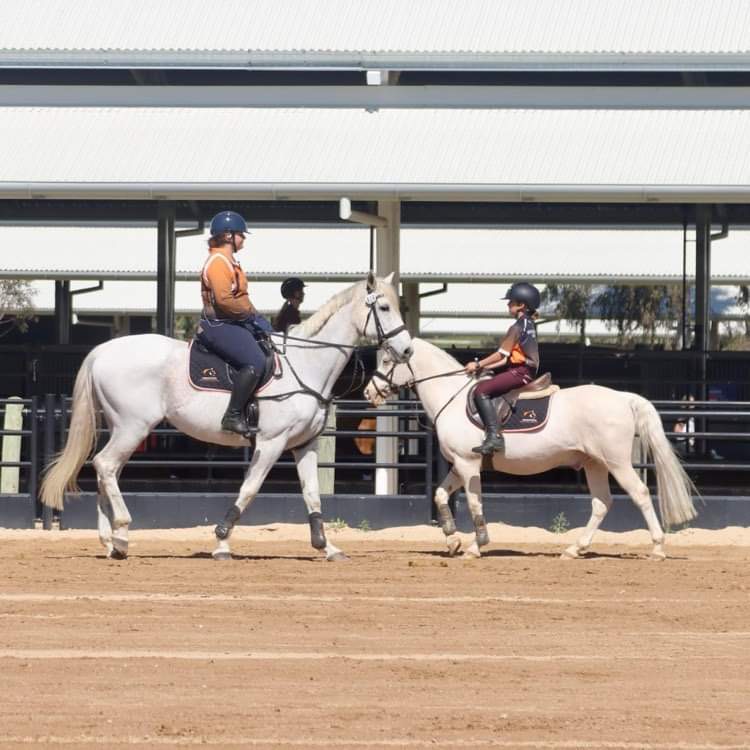Dressage Rules and Tests
What is Dressage?
In Dressage competitions, horse and rider perform a series of predetermined movements, known as ‘figures’ or “movements” in an arena of either 20x60 metres or occasionally 20x40 metres. The arena has 12 lettered markers placed symmetrically indicating where movements are to start and finish and where changes of pace or lead are to occur. In all competitions, the horse has to show the three paces: walk, trot and canter as well as smooth transitions within and between these paces. At Grand Prix level very collected movements such as Piaffe and Passage are required (see Dressage Movements).
Dressage Movements
The Passage
This is a measured, very collected trot, elevated and cadenced. It is characterised by a pronounced engagement of the quarters, a more accentuated flexion of the knees and hocks and the graceful elasticity of the movement. Each diagonal pair of feet is raised and returned to the ground alternatively, with cadence and a prolonged suspension.
The Piaffe
A highly collected trot, cadenced, elevated and giving the impression of being in place. The horse's back is supple and elastic. The quarters are slightly lowered, the haunches with active hocks are well engaged, giving great freedom, lightness and mobility to the shoulders and forehand. Each diagonal pair of feet is raised and returned to the ground alternatively, with even cadence.
The Pirouette
A highly developed form of lateral movement executed on a very small circle with a radius approximately equal to the length of the horse. It can be performed in walk, piaffe or canter. The most important aspect of a good pirouette is that the rhythm and tempo of the gait in which it is performed should be exactly maintained before, during and in the departure from the movement. This can only be satisfactorily achieved if a high degree of collection and impulsion is held.
In the canter pirouette, the hindquarters will be noticeably lowered, through there should be no apparent lifting of the horse's head or forehand which would imply a loss of collection and a consequent flattening of the back. The horse should remain slightly flexed in the direction of the turn throughout, the quarters remaining well controlled to form the true pivot of the movement. He must never show the smallest tendency to drift backwards. Between 6 and 8 strides are desirable in a well controlled canter pirouette, the quality of the movement being judged according to the suppleness, lightness, cadence and regularity.
Flying Change of Leg
In order to make a flying change from canter-left to canter-right, or visa versa, the horse has to reorganise the sequence in which his legs operate in the asymmetrical beat of the gait. This primarily involves the quick adjustment of the hind legs in exactly the same way a child changes its legs while skipping along the pavement. This adjustment can only be made in the very brief moment following the third beat when all four legs are off the ground. A good flying change should flow smoothly through into the first stride of the new lead without any sign of hesitation or of a shortening of a stride, and with no loss of balance. The horse should appear to make the change with pride and elegance. It is only a matter of acquiring sufficient balance and gymnastic freedom of action in order to master the flying changes every four, three, two and one stride.
Lateral Movements
Lateral movements, comprising all movements in a direction other than that on which the horse is aligned, are of four main varieties and all can be used in various forms in all three basic gaits of walk, trot and canter. The standard variations are leg yielding, shoulder-in, traverse (or quarters-in) and half-pass. Leg yielding is not in advanced dressage. All lateral movements share the same purpose of making the horse attentive and obedient to the aids of improving his balance, suppleness and powers of collection. In all of them it is expected that the rhythm of the stride will not be hurried or short.
The Half-pass
The half-pass is widely used is all advanced dressage, and when well performed, is a very elegant and impressive movement. When performed from one side of the arena to the other it is often referred to as 'traversal'. The half-pass is also shown in the form of a zig-zag or counter change of hand, requiring flying changes of leg when done in canter. The horse should be slightly bent in the direction in which he is moving.
How is Dressage judged?
Official EA Dressage tests are judged by EA judges (officials) who are accredited under the National Officials Accreditation Scheme approved by the Australian Sports Commission. Mostly, at least two judges are required for national tests in order to give a balanced assessment. Judges provide marks per movement on a judging sheet, ranking of the class and also helpful comments to improve the performance. The judging sheets are returned to the rider.
At FEI CDIs (international events), five (5) judges from different countries are used; lower level tests (PSG- Intermediate I) may use three (3) judges. At Olympic Games, Championships and World Cup Finals under FEI Rules, seven (7) judges are now used.
As soon as the horse enters the arena it is being judged. The judge is looking for the quality of execution of the various moments against the standards laid out in the FEI Dressage Judges Handbook. The judge actually judges the horse, not the rider, although the rider is given a mark out of 10 for position, seat, correctness and effectiveness of the aids, at the end of the test. Each movement is given a mark out of ten and half marks may be used by the judge. Once totalled, these scores produce a percentage and the rider or team with the highest total score is declared the winner.







